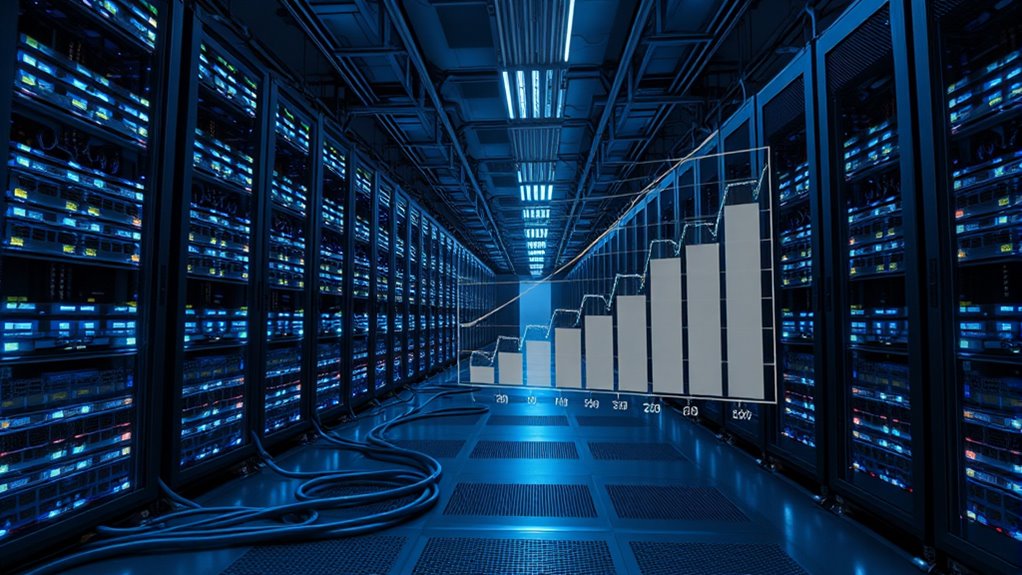As AI models grow more complex and widely used, their energy demands rise sharply, risking grid overloads across the nation. Data centers, already consuming a significant share of electricity, could push power systems to their limits if this trend continues. Cooling, hardware, and infrastructure needs will escalate further, making shortages more likely. If you want to understand how this challenge could impact your energy supply and what’s being done, keep exploring the details.
Key Takeaways
- AI model training consumes increasing amounts of electricity, straining data center power supplies nationwide.
- Growing AI energy demands could cause grid congestion and power shortages during peak usage times.
- Large-scale AI operations require extensive cooling infrastructure, further increasing overall energy consumption.
- Without efficiency improvements, AI growth risks overwhelming existing energy infrastructure and causing widespread bottlenecks.
- Dependence on fossil fuels for energy could exacerbate environmental impacts amid rising AI power needs.

As AI models grow more complex and widespread, their energy demands are reaching critical levels that threaten to strain power grids worldwide. In 2023, data centers used about 4.4% of U.S. electricity, and this figure is expected to triple by 2028 because of AI expansion. Training these models requires thousands of GPUs and TPUs running nonstop for weeks or even months, which considerably ramps up power consumption. By the time we reach 2030 or 2035, data centers could be using as much as 20% of global electricity, creating a real challenge for existing power grid capacity. AI’s contribution to data center energy use has already increased from around 5-15% recently to an estimated 35-50% in the next decade. This growth means that AI could account for roughly 10% of the world’s power demand increase by 2030, making it a major driver of global energy consumption.
AI-driven data center energy use may reach 50% in a decade, threatening global power grids and environmental goals.
Behind this surge lies the intense infrastructure needed to support AI training. High-performance hardware—thousands of GPUs, TPUs, and CPUs—operate in parallel, demanding enormous amounts of electricity. Large tech giants like Google, Microsoft, and Amazon dominate this space because they can afford the costs of hardware, cooling, and electricity. Smaller organizations struggle with longer training times, which means their energy consumption scales proportionally. Additionally, frequent retraining of models to keep pace with evolving data and performance standards further amplifies overall energy use. The complexity of newer models, combined with hardware and software inefficiencies, adds to this burden by increasing heat generation and infrastructure strain. Continuous monitoring of AI behavior is essential to ensure that energy consumption does not spiral out of control, addressing vulnerabilities in AI outputs.
This rising demand puts substantial pressure on power grids and national energy systems. In some countries, data centers could be responsible for half of the electricity demand growth, risking overloads and bottlenecks in local grids. Fluctuations in grid supply and peak power limits can cause performance issues for AI systems and complicate energy management. Managing the heat generated by AI chips is another challenge, requiring advanced cooling systems that further escalate power and water usage. Although renewable energy sources are expanding, fossil fuels are still expected to fill the gap, making it harder to meet global net-zero goals and increasing environmental concerns. Growing AI computational needs are also driving up water consumption for cooling in data centers, which poses risks to water-scarce regions.
To address these challenges, the industry is shifting toward smarter, more efficient infrastructure rather than simply scaling up hardware. Recognizing hardware variability allows systems to adapt dynamically, balancing performance with energy consumption. Real-time adjustments based on thermal conditions, power availability, and network congestion help optimize energy use. Collaboration across hardware, software, and engineering disciplines is essential to develop innovative solutions that improve efficiency and sustainability. High-performance data centers are experimenting with new design approaches to reduce energy waste, but the overall growth in AI energy demands threatens to outpace these efforts. Without significant changes, power bottlenecks could become widespread, slowing innovation and jeopardizing global environmental goals.
Frequently Asked Questions
How Can Individual Users Reduce Their AI Energy Footprint?
You can reduce your AI energy footprint by scheduling non-urgent tasks during off-peak hours when the grid is cleaner. Use smaller or more efficient models whenever possible, and limit unnecessary queries to save energy. Opt for platforms that provide transparent energy reports, so you can make smarter choices. Additionally, promote power-capping GPU settings and choose AI tools designed for energy efficiency to help minimize your environmental impact.
What Are the Economic Impacts of Widespread AI Power Consumption?
Your AI power consumption could cause economic chaos on a grand scale. As demand skyrockets, expect rising energy costs that may spike prices for services and goods, slowing economic growth. Increased operational expenses for data centers might lead to higher prices for AI tools, affecting industries and consumers alike. Plus, heavy reliance on fossil fuels could escalate carbon emissions, risking environmental costs that threaten long-term economic stability.
Are There Sustainable Alternatives to Current AI Training Methods?
Yes, there are sustainable alternatives to current AI training methods. You can adopt smaller, more efficient models through pruning, compression, and quantization, which reduce energy use. Focus on domain-specific language and sparse models to activate only necessary parameters. Use energy-efficient hardware and renewable energy sources, optimize hyperparameters with early stopping, and run workloads during renewable energy peaks. These strategies help lower environmental impact while maintaining AI performance.
How Do Power Shortages Affect AI Research Progress?
Power shortages can gently slow down your AI research progress, making it harder to train and deploy large models efficiently. You might face delays in experimentation, increased costs, or the need to shift focus to less demanding projects. These constraints can also lead to relocating facilities or collaborating more remotely, which may hinder innovation. Ultimately, limited power access challenges your ability to keep pace with AI advancements and maintain competitive edge.
What Policies Could Mitigate Ai’s Energy Demand Nationwide?
You can implement policies that set clear energy efficiency standards for AI data centers, requiring real-time reporting and promoting renewable energy sources. Incentivize investments in efficient infrastructure and advanced scheduling to reduce unnecessary power use. Support grid modernization with AI-managed smart systems, encourage international cooperation on efficiency standards, and foster public-private partnerships to develop cleaner, smarter energy solutions. These steps will help manage AI’s rising energy demand nationwide effectively.
Conclusion
As AI models gobble up energy like a wildfire consuming a forest, you can imagine the grid straining under the relentless blaze. If we don’t curb this appetite, our power infrastructure could buckle, leaving us in darkness when we need it most. Think of it as trying to fill a leaking bucket—the more data you pour in, the faster it drains. Staying mindful now can help prevent this looming blackout, keeping our digital world glowing brightly.









